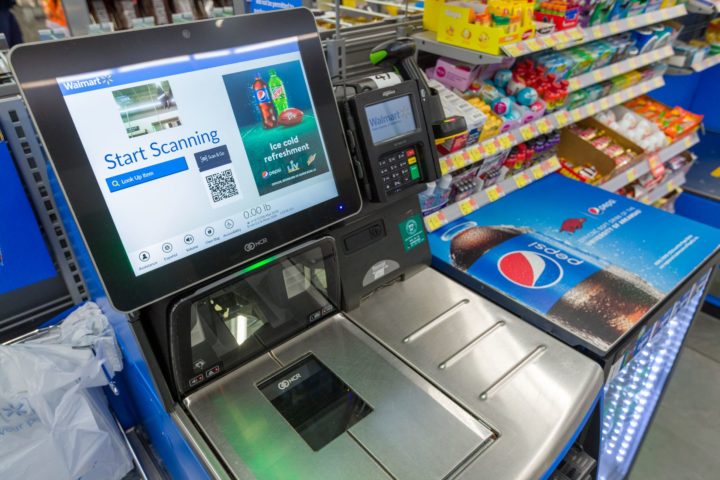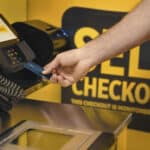
Love it or hate it, there are certainly benefits to self-checkout. But there are some problems, too. So two of the country’s largest retailers are working on improvements that could make self-checkout more convenient for you – and perhaps more lucrative for them.
Together, Walmart and Target have described several new self-checkout systems in recently-published individual patent applications. And if implemented, they could all change the way you engage with self-checkouts at a store near you.
One of Target’s ideas seems the most ambitious of the bunch. Its “Point of Sale System With Customer-Facing Device and Product-Sensing Devices” could be described as an automated upselling service. The system would recommend relevant products to you while you’re checking out. On the one hand, you could find it annoying to have a self-checkout machine pester you to buy more stuff, but it could also save you a trip to another store, by letting you buy additional items you forgot or couldn’t find in the aisles.
“For instance,” the patent application explains, “a customer has multiple boxes of cereal in his/her physical shopping cart but does not have any milk.” The system can suggest that you might consider buying milk as well, in case it slipped your mind.
That’s all well and good, but how are you going to get that milk if you’re in the middle of scanning your stuff? Target describes a system where cameras can peek into your shopping cart and sense what products you’re planning to purchase even before you scan them. This would allow those recommendations to be made early in the checkout process, giving an employee time to help out. If you add milk to your order as you’re checking out, an employee can be notified to grab it for you and bring it to your self-checkout lane while you’re still scanning the rest of your items.
Alternatively, you could choose to have the item delivered to your home, or set aside for pickup at a later time. This would “provide customers with convenient options to still purchase those items without having to run around the store to retrieve them,” Target explains. And if the item happens to be out of stock, you won’t have to go to another store or do without – you could add it to your order to pick up later or have it delivered.
Walmart has its own ideas on how to improve self-checkout, which it describes in two additional patent applications. The first, “Systems and Methods for Self-Returns,” would do just as its name suggests – allow you to return items at self-checkout, instead of at a staffed customer service department.
“Even with the advances in technology and the benefits of self-checkout stations, retail facilities have not adopted a similar model for returns,” the patent documentation explains. “Rather, if a customer wishes to return an item, he or she must do so at a point-of-sale terminal that is operated by an employee of the retail facility.”
Walmart’s system would allow you to bring an item to a self-checkout station, to process your return yourself. You simply scan the item, after which a return label is printed. You attach the label to the item and deposit it in a receptacle and be on your way. A designated employee will go through all of the returned items later in the day, scan the labels to verify the returns, and a refund will be credited to your account.
An additional Walmart self-checkout idea addresses that ever-present problem of self-checkout: theft. “System and Method for Detecting Unpaid Items in Retail Store Transactions” would use cameras similar to those described by Target, to identify items in your shopping cart. Once you scan your purchases, the system will compare the products you scanned with the products in your cart. If it detects a product in your cart that’s not listed on your receipt, it will flag your transaction to an employee.
“The time to complete the process can also be performed in a small amount of time (e.g., less than a second), even before the customer physically leaves the point-of-sale area, allowing actions to be potentially taken there and then,” Walmart explains.
Of course, the presence of all of these cameras that know what’s in your shopping cart simply raises the question – if these systems already know what you’re about to purchase, why do you need to individually scan each item at a self-checkout station at all?
Amazon has already thought of that. But until everyone else gets on board with Amazon’s “no lines, no checkout” system – then no forgotten items, no theft and no long lines at customer service, are at least a few steps in the right direction.
Image source: Walmart











If the self checkouts start taking too long, as they might start suggesting milk that was forgotten for cereal, and an employee has to walk to the back of the store and then bring it back, will mean that I might as well use a real cashier so I dont have to wait behind someone getting all of the things they forgot. Or I will just scan it myself on my phone as some Walmarts have allowed like they do with the Scan and Go app at Sams Club.
I’ve already reduced my shopping at Walmart significantly as they are starting to turn into K-mart. When the move to all self-checkouts is complete, my shopping at Walmart will be done. It’s already bad enough with people that don’t know how to even use the self-checkouts, but 9 times out of 10 the employee working the self-checkout is too busy talking to another employee.